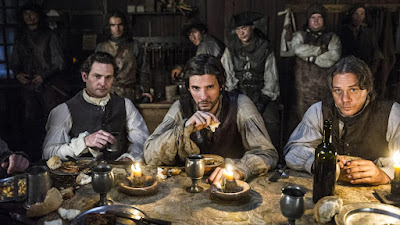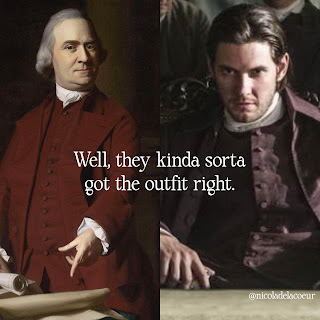Rated R 1 hour 35 minutes Greenwich Entertainment Directed by Anand Tucker Starring Ian McKellen, Gemma Arterton, Ben Barnes, Mark Strong, Lesley Manville, Romola Garai, Alfie Enoch Based on the novel Curtain Call by Anthony Quinn Screenplay by Patrick Marber
A powerful London theatre critic lures a struggling actress into a blackmail scheme that has deadly consequences. [IMDb]
Take just a moment and glance up at that list of actors. The casting director certainly proved they were worth their weight in gold when they secured that lineup. Shame then, only two actors in the bunch were utilized for their unique gifts and talents. But, I’m getting ahead of myself.
“The Critic” began life as a novel by Anthony Quinn entitled “Curtain Call” which focused on a stage actress, Nina Land, the man she was embroiled in an affair with, Stephen Wiley, and a character that was omitted from the screen adaptation. The trio end up in the middle of a murder mystery that spans the novel’s plot. Jimmy Erskine, the eponymous critic for whom the film pays respect, is a side character in the novel who has been elevated to leading man status–and a very different plot to compensate for that revision. Instead, the film alters the focus on Jimmy’s fight for survival as an influential theatre critic who is willing to go to any length to preserve his reputation and livelihood – even if that means blackmail and murder.
We’ve been here before. It’s not an unheard of occurrence when filmmakers option a book for its movie rights and turn that book into something altogether unrecognizable. So, if you’re a fan of Quinn’s novel, take “based on” with the most miniscule grain of salt and enjoy this film as it stands. On its own, it’s built on a relatively sturdy foundation, that is until about three-quarters of the way through, when the plot begins to fall apart. And, I suspect much of that has to do with the deviation from the source material–particularly the swapping of male leads and all of the necessary plot points that needed to be made to compensate for this change.
Ian McKellen stars as theatre critic Jimmy Erskine, who has the power to make or break a career. McKellen is, as always, a joy to watch. His performance is delightfully droll, snarky, and devil-may-care. One can easily see why Patrick Marber was drawn to the character when he read “Curtain Call” and worked alongside Quinn to elevate the character to leading man status. Gemma Arterton is quite engaging as Nina Land, a stage actress in her mid-30s still hoping for her big break and believing Jimmy is the one who could help her get it. The pair have great chemistry as they spar and mend fences; however, it’s when the plot calls for them to collude that things begin to unravel. Jimmy has just as much to hide as Nina does, and they both know each other’s secrets; so, when he blackmails her into a convoluted scheme to help him keep his job and all the societal perks it affords him, this move lacks believability.
 |
| McKellen and Arterton in The Critic. (Greenwich Entertainment) |
Furthermore, in the last quarter of the film, we watch as Jimmy slides into the role of evil villain in a hasty rush to the finish. This flaw in character development is either due to scripting issues or the additional round of editing that took place after the film’s original premiere at TIFF – or, more than likely, some combination of both. This is said not to degenerate the choices Marber and Tucker made; they are, after all, award-winning artists who know what they’re doing. Perhaps they were trying to achieve too much given all of the plot details and ran out of time trying to juggle a large cast that had to navigate murder and blackmail; brewing fascism in pre-WWII London; the seedy side of theatre culture; the negative attitude toward homosexuality; threads of nepotism and bigotry…well, the list goes on and on. At some point, they lost the forest for the trees.
What’s particularly hard to reconcile is the crux of which I began this review. The stellar supporting cast has been reduced to a collection of brief appearances without much, if any, context to properly serve them. One example, although there are many, to prove my case: Why is the Wyley’s marriage in tatters? We get tantalizing hints as to why that could be in rushed conversations between Stephen and his daughter and those with his father-in-law; and while we get plenty of obvious tension between husband and wife, we have no real sense of what it was that made him flee to another woman’s arms. If it was a non-sequitur, one could understand the lack of context; however, it’s a seemingly necessary part of the plot and the glaring omission of vital context leaves the viewer questioning and unsatisfied.
While we’re at it, let’s talk about that supporting cast. Mark Strong (“Kingsman,” “The Imitation Game”) plays David Brooke as a heart-breakingly sympathetic media mogul who isn’t one of Jimmy’s biggest fans and can force him into retirement with the stroke of his pen. Brooke’s daughter, played confidently by Romola Garai (“The Hour,” “Emma”), is brilliant as a contemptible, entitled heiress married to the society portrait painter Stephen Wyley, played by Ben Barnes (“The Chronicles of Narnia: Prince Caspian,” “Shadow and Bone”). This is perhaps one of the more egregious omissions from the book, which had Wyley as the main male character and hero. Barnes’ role was reduced to a few scenes in which the viewer is always left wanting more because he’s so charismatic, expressive, and captivating. To say his lack of screen time was a wasted opportunity is the understatement of all understatements.
 |
| Barnes and Arterton in a scene excised from the final cut. (Greenwich Entertainment) |
Lesley Manville (“Mrs. Harris Goes to Paris,” “The Crown”) portrays Annabel Land, Nina’s mother, a caring stage mother who is perhaps a bit too honest in her criticism but truly has her daughter’s best interests at heart; which is why when Nina meets her cruel fate we feel every ounce of her grief and empathy in the scene she shares with Barnes, comforting the man who could have been her son-in-law. Alfie Enoch (“Foundation,” “How to Get Away with Murder”) plays Tom Turner, Jimmy’s live-in lover and personal assistant. Of the supporting cast members, Enoch gets the most screen time, albeit still lacking. And, like Jimmy, he doesn’t quite resonate with the same energy during the last quarter – and for similar reasons. Without revealing too much of the plot, there are factors that make Tom’s fight for justice intangible, namely the fact that he aids and abets the antagonist willingly and often.
 |
| Enoch and McKellen in The Critic. (Greenwich Entertainment) |
American viewers may not be too familiar with this cast, aside from the leading man; however, abroad and especially in the UK, this is the cream of the crop, which makes it not too fine a point to mention once again what a terrible shame it was that they weren’t given more time to shine.
All this said, what the film gets right it does in spades. The transformation of London to the pre-WWII jazz age era is glorious–from lighting, palette, costuming, art direction, location, set design…it’s all a sumptuous feast for the eyes. The mood evoked by all of these choices is absolutely enthralling and thoroughly consuming. And the performances are well done, despite the incongruous scripting. Nonetheless, “The Critic” remains an entertaining film; but there is a lingering regret that it could have been so much more–maybe even a classic.

































